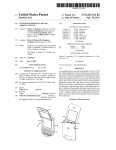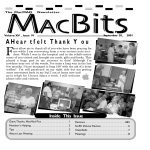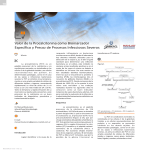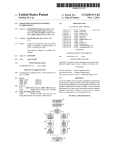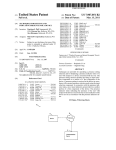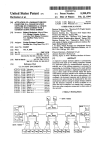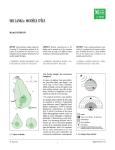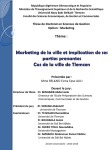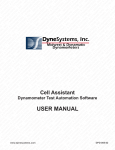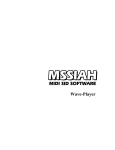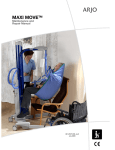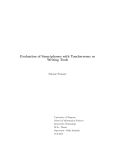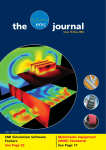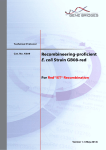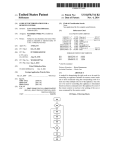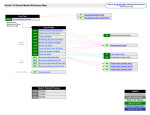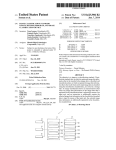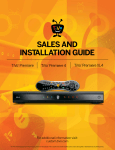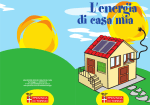Download Method and apparatus for text selection
Transcript
US008543934B1 (12) Ulllted States Patent (10) Patent N0.: Thorsander et al. (54) (45) Date of Patent: METHOD AND APPARATUS FOR TEXT 6,002,390 A SELECTION 6,064,340 A 6,094,197 A 5/2000 Croft et a1. 7/2000 BuXton et a1. 32:12:31) Margaret Elizabeth Kuo, K1tchener (CA); Nils Roger Andersson Reimer, 6,351,634 B1 6,646,572 B1 Malmo (SE) . . . . (CA) 7,098,896 B2 8/2006 Kushler et a1. 9/2006 Liu et a1. S 100007 Rléisiison et a1‘ 7,292,226 B2 11/2007 Matsuura et a1. 7,382,358 B2 6/2008 Kushler et a1. (Continued) FOREIGN PATENT DOCUMENTS CN (22) Filed: 5/2007 7,277,088 B2 Subject to any disclaimer, the term of this patent is extended or adjusted under 35 USC 154(b) by 0 days. Appl. N0.: 13/564,687 2/2002 Shin 11/2003 Brand 7,107,204 B1 7,216,588 B2 (73) Ass1gnee: BlackBerry Limited, Waterloo, Ontano (21) Sep. 24, 2013 12/1999 Masui (75) Inventors: Simon Marti-n ThOI‘SQIIdGIQ'ESlOV (SE); ( * ) Notice: US 8,543,934 B1 101021762 A EP 0844571 A2 Aug. 1, 2012 8/2007 5/1998 (Commued) OTHER PUBLICATIONS Related U-S-APPIiCatiOII Data (63) “Features Included in the T-Mobile G1”, http://WWW.t-m0bilegl. Continuation of application No. 13/459,980, ?led on convT'Moblle'Gl'Feamres'pdf’ 2009' APR 30, 2012 (51) Illt- Cl- (52) G06F 3/048 US. Cl. (Continued) Primary Examiner * Tuyetlien Tran (2013-01) (74) Attorney, Agent, or Firm * Finnegan, Henderson, FaraboW, Garrett & Dunner, LLP USPC .......... .. 715/773; 715/781; 715/863; 715/864 (58) Field of Classi?cation Search USPC (57) .... ., ........................ .. 715/781, 77.3, 863, 864 ABSTRACT A method includes’ displaying a Content Selection icon on a See apphcanon ?le for Complete Search hlstory- touch-sensitive display of an electronic device, detecting _ References Clted touch input at a touch location on the display operable to select a content selection function associated With the content (56) selection icon, and, modifying the displayed content selection U.S. PATENT DOCUMENTS 2 5’26l’009 A 5,664,127 A * lg; icon to display a touch portion at a location on the display golmles etlaL corresponding to said detected touch location and a content 1 H1993 Bislfseret a ' selection portion operatively coupled to, but spatially sepa 9/1997 Anderson et a1. ........... .. 715/776 5,832,528 A 11/1998 KWatinetZ et a1. 5,963,671 A 10/ 1999 Comerford et a1. rated from, the touch P0111011 4 Claims, 11 Drawing Sheets I“ T\t_\/e_ro_e5sTet_ac_clEa_mUs_ _ I et iusto odio dignissimo qui : blanditis praesentium delenit | non eliggendi discinco optio | | | Id est laborum e1 fug. Et 61ofi\’harem quidem rerum facilis 620$ est et expedita disctinoo. TNam libero tempore, cum soluta nobis eligendi optio et quas molestias exceptri sint occaecati non cupiditate 4-’ aut rerum saepe eveniet ut e1 voluptates repudiandae sint et molestiae. ltaque earum rerum hic tenetur a US 8,543,934 B1 Page 2 (56) References Cited 7,394,346 7,443,316 7,479,949 7,487,461 7,530,031 7,661,068 7,698,127 7,886,233 8,023,930 8,065,624 8,201,087 U'S' PATENT DOCUMENTS B2 7/2008 Bodin B2 10/2008 Lim B2 1/2009 Jobs et al. B2 2/2009 Zhai et a1. B2 5/2009 IWamura et a1. B2 2/2010 Lund B2 4/2010 Trower, 11 er :11 B2 2/2011 Rainisto et a1. B2 9/2011 Won B2 11/2011 Morin et al. B2 6/2012 Kay et al. 2002/0097270 A1* 2002/0154037 A1 2002/0180797 A1 7/2002 2009/0247112 A1 10/2009 Lundy et al. 2009/0251410 A1 2009/0254818 A1 10/2009 Mori et al. 10/2009 Jania et al. 2009/0259962 2009/0265669 2009/0284471 2009/0295737 2009/0307768 2009/0313693 2010/0020033 2010/0020036 2010/0045705 2010/0052880 2010/0070908 2010/0079413 Keely et al. ................. .. 345/764 10/2002 HoustOn 12/2002 Bachmann A1 A1 A1 A1 A1 A1 A1 A1 A1 A1 A1 A1 10/2009 10/2009 11/2009 12/2009 12/2009 12/2009 1/2010 1/2010 2/2010 3/2010 3/2010 4/2010 Beale Kida et al. Longe et al. Goldsmith et al. Zhang et a1. Rogers NWosu Hui et al. Vertegaal et a1. Laitinen Mori et al. KaWashima et al. 2010/0095238 A1 4/2010 2010/0115402 A1 2010/0127991 A1 5/2010 Knaven et al. 5/2010 Yee Baudet ........................ .. 715/784 2004/0111475 A1 6/2004 SchultZ 2010/0131900 A1 5/2010 Spetalnick 2004/0135818 A1 2004/0140956 A1 7/2004 Thomson et al. 7/2004 Kushler et al. 2010/0141590 A1 2010/0156813 A1 6/2010 MarkieWicZ et a1. 6/2010 Duane et a1, 2004/0153963 2005/0017954 2005/0024341 2005/0039137 2005/0052425 2005/0093826 2005/0195173 2006/0022947 2006/0033724 2006/0053387 2006/0176283 2006/0209040 2006/0239562 2006/0253793 A1 8/2004 Simpson et al. A1 1/2005 Kay et al. A1 2/2005 Gillespie et al. A1 2/2005 Bellwood et al. A1 3/2005 Zadesky et al. A1 5/2005 Huh A1 9/2005 McKay A1 2/2006 Grif?n et al. A1 2/2006 Chaudhri et a1. A1 3/2006 Ording A1 8/2006 Suraqui A1 9/2006 Garside et al. A1* 10/2006 Bhattacharyay et al. A1 11/2006 Zhai et a1. 382/188 2010/0156818 2010/0161538 2010/0197352 2010/0199176 2010/0225599 2010/0235726 2010/0253620 2010/0257478 2010/0259482 2010/0259561 2010/0277424 2010/0287486 2010/0292984 2010/0295801 A1 A1 A1 A1 A1 A1 A1 A1 A1 A1 A1 A1 A1 A1 6/2010 6/2010 8/2010 8/2010 9/2010 9/2010 10/2010 10/2010 10/2010 10/2010 11/2010 11/2010 11/2010 11/2010 Burrough et al. Kennedy, Jr. et al. Runstedler et a1. Chronqvist Danielsson et al. Ording et al. Singhal Longe et a1. Ball Forutanpour et al. Chang et al. Coddington Huang et a1, Bestle et al. 2006/0265648 A1 11/2006 Rainisto et al. 2010/0313127 A1 12/2010 Gosper et al. ............... .. 715/708 2006/0265668 2006/0279548 2007/0046641 2007/0061753 2007/0150842 2007/0156394 11/2006 12/2006 3/2007 3/2007 6/2007 7/2007 2010/0313158 2010/0315266 2010/0325721 2010/0333027 2011/0010655 2011/0018812 A1 A1 A1 A1 A1 A1 12/2010 12/2010 12/2010 12/2010 1/2011 1/2011 2011/0029862 A1 2/2011 Scott et al. 2011/0035696 2011/0041056 2011/0043455 2011/0060984 A1 A1 A1 A1 2/2011 2/2011 2/2011 3/2011 ElaZari et al. Grif?n et al. Roth et al. Lee Yeh et al. A1 A1 A1 A1 A1 A1 2007/0157085 A1* 2007/0256029 2007/0263932 2008/0100581 2008/0122796 A1 A1 A1 A1 Rainisto Geagh?n Lim Ng et al. Chaudhfi 6t 31~ Banerjee et al. 7/2007 Peters ......................... .. 715/531 11/2007 11/2007 5/2008 5/2008 Maxwell Bernardin et al. Fux Jobs et al. Lee et al. Gunawardana et al. Bandyopadhyay et al. Martensson et al. Dostie et al. Baird 2008/0126387 A1* 5/2008 Blinnikka ................... .. 707/102 2011/0061029 A1 3/2011 2008/0136587 A1 6/2008 Orr 2011/0063231 A1 3/2011 Jakobs et al. 2008/0141125 2008/0158020 2008/0184360 2008/0189605 2008/0231610 2008/0259040 A1 6/2008 Ghassabian Grif?n Kornilovsky et al. Kay et al. Hotelling et al. Ording et al. A1 A1 A1 A1 A1 2008/0273013 A1 2008/0281583 A1 2008/0304890 A1 7/2008 7/2008 8/2008 9/2008 10/2008 11/2008 11/2008 12/2008 2008/0309644 A1* 2008/0316183 A1 2008/0318635 A1 2011/0078613 A1 A1 A1 A1 A1 A1 A1 A1 A1 Ku Yeh et a1. Karlsson 12/2008 Arimoto ..................... .. 345/173 12/2008 Westerman et al. 2011/0193797 A1 2011/0202835 A1 8/2011 8/2011 Unruh Jakobsson et al. .......... .. 715/702 12/2008 YOOIl 6t 31 2011/0202876 A1 8/2011 Badger et al. 2009/0002326 A1 1/2009 Pihlaja 2011/0209087 A1 2009/0025089 2009/0058823 2009/0058830 2009/0066668 2009/0077464 2009/0085881 2009/0094562 2009/0125848 2009/0132576 2009/0144667 1/2009 3/2009 3/2009 3/2009 3/2009 4/2009 4/2009 5/2009 5/2009 6/2009 2011/0233407 2011/0239153 2011/0242138 2011/0248945 2011/0249076 2011/0256848 2011/0285656 2011/0302518 2011/0305494 2012/0005576 A1 A1 A1 A1 A1 A1 A1 A1 A1 A1 3/2011 Bangalore Rider et al. Huang et al. Dahl Gargi et al. Kim 4/2011 4/2011 4/2011 4/2011 5/2011 6/2011 7/2011 7/2011 Levine et al. Slothouber et a1. Shin et al. 2011/0086674 2011/0090151 2011/0099505 2011/0099506 2011/0119623 2011/0148572 2011/0171617 2011/0179355 Martin et al. Kocienda HerZ et al. Kim et al. Goldsmith et al. Keam Jeong et al. Keohane et al. Miller et al. Christoffersson et al. A1 A1 A1 A1 A1 A1 A1 A1 A1 A1 8/2011 Guyot-Sionnest 9/2011 9/2011 10/2011 10/2011 10/2011 10/2011 11/2011 12/2011 12/2011 1/2012 Wu et al. Carter et a1. Tribble Higashitani Zhou et al. Bok et al. Yaksick et al. Zhang Kang Assadollahi 2009/0160800 A1 6/2009 Liu et al. 2012/0023447 A1 1/2012 Hoshino et al. ............. .. 715/823 2009/0167700 A1 7/2009 Westerman et al. 2012/0029910 A1 2/2012 Medlock et al. 2009/0174667 A1 7/2009 Kocienda et al. 2012/0030566 A1 2/2012 Victor ......................... .. 715/702 2009/0193334 A1 7/2009 Assadollahi 2012/0030623 A1 2009/0213081 A1 8/2009 Case, Jr. 2012/0036469 A1 2/2012 HoellWarth 2/2012 Suraqui 2009/0228792 A1* 2009/0228842 A1 * 9/2009 Van Os et al. ............... .. 715/702 9/2009 Westerman et al. ........ .. 715/863 2012/0053887 A1 2012/0062465 A1 3/2012 Nurmi 3/2012 Spetalnick US 8,543,934 B1 Page 3 2012/0062494 2012/0068937 2012/0079373 2012/0092278 2012/0110518 2012/0119997 2012/0149477 2012/0159317 2012/0166696 2012/0167009 A1 A1 A1 A1 A1 A1 A1 A1 A1 A1 2012/0223959 A1 3/2012 3/2012 3/2012 4/2012 5/2012 5/2012 6/2012 6/2012 6/2012 6/2012 Hsieh et al. Backlund et al. Kocienda et al. Yamano Chan et al. GutowitZ Park et al. Di Cocco et al. Kallio et al. Davidson et a1. 9/2012 Lengeling RaZZaghi .................... .. 345/173 Extended European Search Report dated Sep. 10, 2012, issued in European Application No. 121662472 (8 pages). Extended European Search Report dated Sep. 21, 2012, issued in European Application No. 121642409 (6 pages). Extended European Search Report dated Sep. 25, 2012, issued in European Application No. 111927133 (7 pages). Extended European Search Report dated Sep. 3, 2012, issued in European Application No. 121643001 (7 pages). Google Mobile HelpiEditing text, http://support.google.com/mo bile/bin/answer.py?hl:en&answer:168926, date of access: Jun. 6, 2012 (2 pages). 2012/0268388 A1* 10/2012 2012/0306772 A1 12/2012 Tan et al. GSMArenaiSamsung announce s5600 & s5230 full touch 2012/0311437 A1 12/2012 Weeldreyer et a1. midrange phones, http://www.gsmarena.com/samsungiannouncei s5600iandis5230ifullitouchimidrangeiphones-news-825. FOREIGN PATENT DOCUMENTS EP EP EP EP EP EP EP EP EP EP EP EP EP EP EP EP EP EP EP JP JP KP WO WO WO WO WO WO WO WO WO WO WO WO WO WO WO WO WO WO 0880090 0880090 1847917 1847917 1850217 1909161 2077491 2109046 2128750 2146271 2184686 2256614 2282252 2293168 2320312 2336851 2402846 2420925 2431842 2011-197782 2012-68963 KR20120030652 03/029950 03/054681 2004/001560 2006/100509 2007/068505 2007/076210 2007/134433 WO2008/057785 2009/019546 2010/035574 WO2010/035574 WO2010/099835 WO2010/112841 2011/073992 WO2011/073992 2011/098925 WO2011/113057 2012/043932 A2 A3 A2 A3 A2 A1 A1 A1 A2 A2 A1 A1 A1 A1 A1 A2 A2 A2 A2 A A A A2 A1 A1 A2 A1 A1 A1 A2 A2 A1 A1 A1 A1 A2 A2 A1 A1 A1 11/1998 11/1998 10/2007 10/2007 10/2007 4/2008 7/2009 10/2009 12/2009 1/2010 5/2010 12/2010 2/2011 3/2011 5/2011 6/2011 1/2012 2/2012 3/2012 10/2011 4/2012 3/2012 4/2003 7/2003 12/2003 9/2006 6/2007 7/2007 11/2007 5/2008 2/2009 4/2010 4/2010 9/2010 10/2010 6/2011 6/2011 8/2011 9/2011 4/2012 OTHER PUBLICATIONS php, Mar. 10, 2009. Hardware SphereiSamsung s5600 & s5230 Touchscreen phones, http://hardwaresphere.com/2009/03/09/samsung-s5600-s5230 touchscreen-phones/, Mar. 9, 2009. International Search Report and Written Opinion issued in Interna tional Application No. PCT/EP2012/057944, on Oct. 12, 2012, (10 pages). International Search Report and Written Opinion issued in Interna tional Application No. PCT/IB2011/003273, on Jun. 14, 2012, (8 pages). International Search Report and Written Opinion mailed Sep. 10, 2012, issued for International Application No. PCT/EP2012/057945 (11 pages). iPhone User Guideifor iPhone OS 3.1 Software, 2009 (217 pages). Madhvanath, Sriganesh, HP-Gesture based computing interfaces, Mar. 2008. Manual del usuario Samsung MomentTM with GoogleTM, dated May 20, 2012 (224 pages). Merrett, Andy, “iPhone OS 3.0: How to cut, copy and paste text and images”, http://www.iphonic.tv/2009/06/iphoneiosi30ihowi toicuticopyiahtml, Jun. 18, 2009, XP002684215, (8 pages). Mobile Tech NewsiSamsung launches new Gesture Lock touchscreen handsets, http://www.mobiletechnews.com/info/2009/ 03/11/124559.html, Mar. 11,2009. Partial European Search Report; Application No. 101605905; Sep. 16, 2010. Sprint Support Tutorial Set the Screen Lock PatterniSamsung Moment, http:// support . sprint.com/ support/tutorial/ Setithei ScreeniLockfPatternfSamsunggMoment/ 10887-171, date of access: May 31, 2012 (9 pages). Sprint Support Tutorial Unlock a Forgotten Lock PatterniSamsung Moment, http :// support. sprint.com/ support/tutorial/UnlockiaiFor gotteniLockiPatterniSamsungiMoment/10887-339, date of access: May 31, 2012 (7 pages). SupportiSprint Cell Phones SPH-M900iSamsung Cell Phones, http://www. samsung.com/us/support/owners/product/SPH M900?tabContent-content2, date of access: May 31, 2012 (1 page). T-Mobile ForumiHelp & How toiHidden Pattern, http://forums. t-mobile.com/tmbl/board/message?board.id:Android3&message. BlackBerry SeekeriFreewareiPattern Lock v1.0.7, http://www. id:3511&query.id:52231#M3511, Oct. 23, 2008. T-Mobile ForumiHelp & How toiScreen Unlock Pattern, http:// blackberryseeker.com/applications/preview/Pattern-Lock-v107. forums.t-mobile.com/tmbl/board/messagei’board.id:Android3 aspx, Jul. 28, 2009. Chong et al., Exploring the Use of Discrete Gestures for Authentica tion, IFIP International Federation for Information Processing, 2009. Conveniently select text, images, annotations, etc. in a PDF or any other text format on a touch based mobile/tablet device, IP.com Journal, Mar. 1, 2011, XP013142665, (10 pages). &message.id:6015&query.id:50827#M6015, Oct. 22, 2008. T-Mobile launches the highly anticipated T-Mobile G1, Oct. 22, 2008. US. Office Action dated Oct. 15, 2012, issued in US. Appl. No. 13/560,270 (15 pages). US. Office Action dated Oct. 17, 2012, issued in US. Appl. No. 13/563,943 (17 pages). DROID X by Motorola © 2010 Screen shots. US. Office Action dated Oct. 18, 2012, issued in US. Appl. No. DROID X by Motorola © 2010 User Manual (72 pages). European Search Report dated Feb. 28, 2011, issued in European Patent Application No. 101605905. Extended European Search Report dated Aug. 24, 2012, issued in US. Office Action dated Oct. 23, 2012, issued in US. Appl. No. 13/563,182 (12 pages). 12/764,298 (41 pages). US. Office Action dated Oct. 25, 2012, issued in US. Appl. No. European Application No. 121661151 (5 pages). 13/459,732 (15 pages). Extended European Search Report dated Oct. 9, 2012, issued in U.S. Of?ce Action dated Oct. 5, 2012, issued in US. Appl. No. European Application No. 121662449 (6 pages). 13/447,835 (20 pages). Extended European Search Report dated Sep. 10, 2012, issued in U.S. Of?ce Action dated Sep. 10, 2012, issued in US. Appl. No. European Application No. 121662464 (6 pages). 13/524,678 (12 pages). US 8,543,934 B1 Page 4 US. Of?ce Action dated Sep. 28, 2012, issued in US. Appl. No. iPhone J .D. Typing Letters or Symbols That Are Not on the iPhone 13/494,794 (14 pages). 2012, (38 pages). Keyboard dated Mar. 19, 2010, accessed “http://www.iphonej d.com/ iphoneij d20 10/03/typing-letters-or-symbols-that-are-not-on-the iphone-keyboard.html” on Feb. 26, 2013 (3 pages). U.S. Of?ce Action for US. Appl. No. 13/482,705, dated Aug. 7, Notice of Allowance dated Mar. 15, 2013, issued in US. Appl. No. U.S. Of?ce Action for US. Appl. No. 12/764,298, dated Jul. 20, 2012, (10 pages). User Guide Samsung Moment(TM) with Google(TM), dated Dec. 4, 2009 (122 pages). User Guide Samsung Moment(TM) with Google(TM), dated Mar. 2, 2010 (218 pages). “Windows Mobile CaféiSoftware (Freeware): Touchpal, Let’s Try Tabbing Up to 300 Chars/Min”, Nov. 4, 2007, retrieved from URL:http://windows-mobile-cafe.blogspot.nl/2007/1l/software freewaretouchpal-lets-try.html, accessed online Jan. 18, 2013 (2 13/373,356 (25 pages). Of?ce Action dated Dec. 28, 2012, issued in US. Appl. No. 13/459,301 (22 pages). Of?ce Action dated Jan. 22, 2013, issued in US. Appl. No. 13/564,687 (19 pages). Of?ce Action dated Jan. 29, 2013, issued in US. Appl. No. 13/563,182 (19 pages). Of?ce Action dated Jan. 7, 2013, issued in US. Appl. No. 13/564,070 pages). (21 pages). European Examination Report datedApr. 5, 2013, issued in European Application No. 121801906 (7 pages). Of?ce Action dated Jan. 7, 2013, issued in US. Appl. No. 13/564,697 European Partial Search Report dated Jan. 16, 2013, issued in Euro Of?ce Action dated Mar. 12, 2013, issued in US. Appl. No. (19 pages). pean Application No. 121826127 (5 pages). 13/560,796 (22 pages). European Partial Search Report dated Mar. 7, 2013, issued in Euro Of?ce Action dated Nov. 14, 2012, issued in US. Appl. No. pean Application No. 121845747 (5 pages). Extended European Search Report dated Aug. 24, 2012, European Application No. 121724587 (6 pages). Extended European Search Report dated Aug. 31, 2012, European Application No. 121661706 (7 pages). Extended European Search Report dated Feb. 28, 2013, European Application No. 121826101 (7 pages). Extended European Search Report dated Jan. 25, 2013, European Application No. 121665202 (8 pages). Extended European Search Report dated Mar. 8, 2013, European Application No. 121826119 (8 pages). Extended European Search Report dated Nov. 22, 2012, European Application No. 121728927 (7 pages). Extended European Search Report dated Sep. 25, 2012, European Application No. 121764534 (7 pages). Extended European Search Report dated Sep. 25, 2012, European Application No. 121801906 (8 pages). 13/572,232 (24 pages). issued in Of?ce Action dated Nov. 16, 2012, issued in US. Appl. No. issued in Of?ce Action dated Nov. 8, 2012, issued in US. Appl. No. issued in Of?ce Action dated Oct. 26, 2012, issued in US. Appl. No. issued in PCT International Search Report and Written Opinion dated Jan. 24, 2013, issued in International Application No. PCT/CA2012/050274 issued in 13/554,583 (21 pages). 13/373,356 (18 pages). 13/554,436 (22 pages). (9 pages). issued in PCT International Search Report and Written Opinion dated Nov. 7, 2012, issued in International Application No. PCT/CA2012/050362 issued in (9 pages). issued in PCT International Search Report and Written Opinion dated Nov. 8, 2012, issued in International Application No. PCT/CA2012/050405 (12 pages). Final Of?ce Action dated Jan. 18, 2013, issued in US. Appl. No. Swype Product Features, accessed online at http://www.swype.com/ about/speci?cations/ on Feb. 25, 2013 (2 pages). U.S. Appl. No. 13/601,736, ?led Aug. 31, 2012 (44 pages). U.S. Appl. No. 13/616,423, ?led Sep. 14, 2012 (30 pages). U.S. Appl. No. 13/773,812, ?led Feb. 22, 2013 (94 pages). Wang, Feng, et al., “Detecting and Leveraging Finger Orientation for Interaction with Direct-Touch Surfaces”, UIST ’09, Oct. 4-7, 2009, 13/482,705 (18 pages). Victoria, British Columbia, Canada (10 pages). Final Of?ce Action dated Apr. 4, 2013, issued in US. Appl. No. 13/447,835 (20 pages). Final Of?ce Action dated Feb. 1, 2013, issued in US. Appl. No. 13/563,943 (17 pages). Final Of?ce Action dated Feb. 28, 2013, issued in US. Appl. No. 13/524,678 (21 pages). Final Of?ce Action dated Mar. 15, 2013, issued in US. Appl. No. 13/572,232 (36 pages). * cited by examiner US. Patent U Sep. 24, 2013 134'“ 146 2 US 8,543,934 B1 Other Short-range subsystems 136 Sheet 1 0f 11 Accelerometer 110 ‘ ~ communications ~ Microphone 130 ~ Speaker 128 7 Data port 126 ~ Auxiliary V0 124 ~ Force sensor 122 ' Actuator 120 Memory Operating 108 system 2 J‘ 132 ' ' RAM Mam processor Programs Decoder ' ___________ _ _| S ' Controller I ' S 148 106 g _ _ 104“ Communication subsysem ' S I I Touch sensors :> Display l 1 16 | 1 14 "A : T 112 l _ _ _ _ _ _ _ _ _ _ _’ _ _. \ 102 I 118 150 138~ SIM/RUIM Power source FIG. 1 w 142 US. Patent Sep. 24, 2013 Sheet 2 0f 11 \@ MENU US 8,543,934 B1 1 FIG. 2 100 301 #128 /118 FIG. 3 US. Patent Sep. 24, 2013 r US 8,543,934 B1 Sheet 5 0f 11 l At Ivero eosI et I accusam us I I :I et blanditis |usto odlo praesentium d|gn|ss|modelenit qul / ,/ | non ellggendl dlsclnoo optlo /// I 1 / I41 | / / / / 610’k/Id est laberum et fug. E1 H | harem|qu|dem rerum facllls I . . . 6201 /est etiexpedlta dlsctlnco. Nam llbero tempore, cum soluta nobis eligendi optio et quas molestias exceptri sint occaecati non cupiditate 4' aut rerum saepe eveniet ut et voluptates repudiandae sint et molestiae. Itaque earum rerurn hic tenetur a 610“ Id est laborum et fug. Et lharemhuidem rerum facilis est et expedita disctinco. Nam libero tempore, cum 621 ’\ Eoluta nobis eligendi optio et quas molestias exceptri sint occaecati norllgupiditate 7 630 FIG. 6B Id est laborum et fug. Et 610“ ’harem|quidem rerum facms est et expedita disctinco. Nam libero tempore, cum 622A 'soluta nobis eligendi optio et quas molestias exceptri sint occaecati non cupiditate FIG. 6C 630 US. Patent Sep. 24, 2013 Sheet 7 0f 11 eligendi US 8,543,934 B1 8CFIG. 810 820 810’ F8AIG. 820 830 US. Patent Sep. 24, 2013 Sheet 9 0f 11 Display a content selection icon on a touch- US 8,543,934 B1 N10”) sensitive display of an electronic device . . Detect touch input at a touch location on the M1020 display operable to select a content selection function associated with the content selection icon Modify the displayed content selection icon to display a touch portion at a location on the display corresponding to said detected touch location and a content selection portion operatively coupled to, but spatially separated from the touch portion FIG. 10 M1030 US. Patent Sep. 24, 2013 Sheet 10 0f 11 Detect a location of a text selection icon on a US 8,543,934 B1 “1110 display of an electronic device Detect touch input representing a selection of text ~1120 displayed on the display using the text selection icon If the detected location of the text selection icon is @1130 maintained within a zone adjacent an edge of the display, the displayed text is selected on a row by row basis If the detected location of the text selection icon moves outside said zone, the displayed text is selected on a letter by letter basis FIG. 11 K11 140 US. Patent Sep. 24, 2013 Sheet 11 0f 11 US 8,543,934 B1 Detect a first touch input representing a selection M1210 of multiple rows of text displayed on a touch sensitive display of the electronic device 7 Determine whether a complete row of text has M1220 been selected from a start point or to an end point of the selected text 7 Display a paragraph selection handle proximal to @1230 said row, the paragraph selection handle being responsive to a second touch input to place the electronic device in a paragraph selection mode for the selection of text FIG. 12 US 8,543,934 B1 1 2 METHOD AND APPARATUS FOR TEXT SELECTION FIG. 12 is a ?owchart illustrating a method of paragraph selection in accordance with the disclosure. The present application is a continuation of application Ser. No. 13/459,980, ?led Apr. 30, 2012, titled “METHOD AND DETAILED DESCRIPTION The following describes an apparatus for and method of APPARATUS FOR TEXT SELECTION,” the contents of determining a selection of a selection option based on received user input. which is incorporated herein by reference in its entirety. For simplicity and clarity of illustration, reference numer als may be repeated among the ?gures to indicate correspond FIELD OF THE TECHNOLOGY Background ing or analogous elements. Numerous details are set forth to provide an understanding of the examples described herein. The examples may be practiced without these details. In other Electronic devices, including portable electronic devices, instances, well-known methods, procedures, and components have gained widespread use and may provide a variety of functions including, for example, telephonic, electronic mes saging and other personal information manager (PIM) appli cation functions. Portable electronic devices include, for example, several types of mobile stations such as simple cellular telephones (feature phones), smart phones, wireless personal digital assistants (PDAs), tablet computers, and lap 20 are not described in detail to avoid obscuring the examples described. The description is not to be considered as limited to the scope of the examples described herein. The disclosure generally relates to an electronic device, such as a portable electronic device or non-portable electronic device. Examples of portable electronic devices include top computers with wireless 802.11 or Bluetooth® capabili ties. pagers, feature phones, cellular smart-phones, wireless orga Portable electronic devices such as PDAs or smart tele niZers, personal digital assistants, wirelessly enabled note phones are generally intended for handheld use and ease of mobile, or handheld, wireless communication devices such as 25 portability. Smaller devices are generally desirable for port ability. A touch-sensitive display, also known as a touch screen display, is particularly useful on handheld devices, which are small and have limited space for user input and output. The information displayed on the touch-sensitive dis plays, such as text, may be modi?ed based on the functions tronic device may be a portable electronic device without wireless communication capabilities, such as handheld elec tronic games, digital photograph albums, digital cameras, 30 built-in monitors or displays in fumiture or appliances, and so forth. Improvements in devices with touch-sensitive displays, 35 Examples of the present proposed approach will now be 40 tion functions, including data and voice communications, are performed through a communication subsystem 104. Data received by the electronic device 100 is decompressed and decrypted by a decoder 106. The communication subsystem 45 network 150. The wireless network 150 may be any type of ings, in which: FIG. 1 is a block diagram of a portable electronic device in accordance with the disclosure; FIG. 2 is a front view of a smartphone in accordance with 104 receives messages from and sends messages to a wireless example embodiments of the present disclosure; wireless network, including, but not limited to, data wireless networks, voice wireless networks, and networks that support FIG. 3 is a front view of a tablet computer is accordance with example embodiments of the present disclosure; both voice and data communications. A power source 142, FIGS. 4A to 4C illustrate an electronic device in accor dance with an embodiment showing the initiation of a para Example Electronic Device A block diagram of an example of an electronic device 100 is shown in FIG. 1. The electronic device 100 includes mul tiple components, such as a processor 102 that controls the overall operation of the electronic device 100. Communica BRIEF DESCRIPTION OF DRAWINGS described in detail with reference to the accompanying draw media players, e-book readers, and so forth. Examples of non portable electronic devices include desktop computers, elec tronic white boards, smart boards utilized for collaboration, and operations being performed. including the selection of content on those devices, are desir able. book computers, tablet computers, mobile intemet devices, electronic navigation devices, and so forth. The portable elec such as one or more rechargeable batteries or a port to an 50 graph selection mode; FIGS. 5A and 5B illustrate an electronic device in accor external power supply, powers the electronic device 100. The processor 102 interacts with other components, such as a Random Access Memory (RAM) 108, memory 110, a dance with an embodiment showing example touch inputs; touch-sensitive display 118, one or more actuators 120, one or FIGS. 6A to 6C illustrate a method of switching between row and letter selection in accordance with the disclosure; more force sensors 122, an auxiliary input/output (I/O) sub system 124, a data port 126, a speaker 128, a microphone 130, short-range communications 132 and other device sub systems 134. The touch-sensitive display 118 includes a dis 55 FIGS. 7A to 7C illustrate an electronic device in accor dance with an embodiment showing the movement of content in response to a touch input; FIGS. 8A to 8C show a selection handle in accordance with the disclosure; play 112 and touch sensors 114 that are coupled to at least one controller 116 that is utiliZed to interact with the processor 60 FIGS. 9A and 9B illustrate an electronic device in accor dance with an embodiment showing the extension of a selec acters, symbols, images, icons, and other items that may be tion handle in response to user input; FIG. 10 is a ?owchart illustrating a method of modifying a selection icon in accordance with the disclosure; FIG. 11 is a ?owchart illustrating a method of row-by-row selection in accordance with the disclosure; and, 102. Input via a graphical user interface is provided via the touch-sensitive display 118. Information, such as text, char displayed or rendered on a electronic device, is displayed on the touch-sensitive display 118 via the processor 102. The 65 processor 102 may also interact with an accelerometer 136 that may be utiliZed to detect direction of gravitational forces or gravity-induced reaction forces. US 8,543,934 B1 4 3 To identify a subscriber for network access, the electronic Removable User Identity Module (SIM/RUIM) card 138 for may be a touch at a location that is generally unchanged over a period of time or is associated with the same selection item for a period of time. communication with a network, such as the wireless network 150. Alternatively, user identi?cation information may be The optional actuator(s) 120 may be depressed or activated by applying suf?cient force to the touch-sensitive display 118 programmed into memory 1 1 0. The electronic device 100 includes an operating system 146 and software programs, applications, or components 148 that are executed by the processor 1 02 and are typically stored to overcome the actuation force of the actuator 120. The device 100 may utilize a Subscriber Identity Module or a actuator(s) 120 may be actuated by pressing anywhere on the touch-sensitive display 118. The actuator(s) 120 may provide input to the processor 102 when actuated. Actuation of the actuator(s) 120 may result in provision of tactile feedback. Optional force sensors 122 may be disposed in conjunction in a persistent, updatable store such as the memory 110. Additional applications or programs may be loaded onto the with the touch-sensitive display 118 to determine or react to electronic device 100 through the wireless network 150, the forces applied to the touch-sensitive display 118. The force auxiliary I/O subsystem 124, the data port 126, the short sensor 122 may be disposed in line with a pieZo actuator 120. The force sensors 122 may be force-sensitive resistors, strain gauges, pieZoelectric or pieZoresistive devices, pressure sen range communications subsystem 132, or any other suitable subsystem 134. A received signal such as a text message, an e-mail mes sage, or web page download is processed by the communica tion subsystem 104 and input to the processor 102. The pro cessor 102 processes the received signal for output to the display 112 and/ or to the auxiliary I/O subsystem 124. A subscriber may generate data items, for example e-mail mes sors, 20 sages, which may be transmitted over the wireless network 150 through the communication subsystem 104. For voice communications, the overall operation of the electronic device 100 is similar. The speaker 128 outputs audible infor mation converted from electrical signals, and the microphone 25 30 force-sensitive extending around the periphery of the display area. The dis play area generally corresponds to the area of the display 112. Information is not displayed in the non-display area by the display, which non-display area is utiliZed to accommodate, for example, electronic traces or electrical connections, adhe sives or other sealants, and/or protective coatings around the edges of the display area. The non-display area may be housing or frame of the electronic device. Typically, no pixels of the display are in the non-display area, thus no image can be displayed by the display 112 in the non-display area. Optionally, a secondary display, not part of the primary dis play 112, may be disposed under the non-display area. Touch gauge, optical imaging, dispersive signal technology, acous tic pulse recognition, and so forth. A capacitive touch-sensi composites, referred to as an inactive area and is not part of the physical 130 converts audible information into electrical signals for processing. The touch-sensitive display 118 may be any suitable touch sensitive display, such as a capacitive, resistive, infrared, surface acoustic wave (SAW) touch-sensitive display, strain quantum tunneling switches, or other suitable devices The touch-sensitive display 118 includes a display area in which information may be displayed, and a non-display area 35 sensors may be disposed in the non-display area, which touch sensors may be extended from the touch sensors in the display tive display includes one or more capacitive touch sensors area or distinct or separate touch sensors from the touch 114. The capacitive touch sensors may comprise any suitable material, such as indium tin oxide (ITO). sensors in the display area. A touch, including a gesture, may be associated with the display area, the non-display area, or One or more touches, also known as touch contacts or touch events, may be detected by the touch-sensitive display both areas. The touch sensors may extend across substantially 40 118. The processor 102 may determine attributes of the touch, including a location of the touch. Touch location data may Example Smartphone Electronic Device include data for an area of contact or data for a single point of contact, such as a point at or near a center of the area of contact. The location of a detected touch may include x and y components, e. g., horiZontal and vertical components, respectively, with respect to one’s view of the touch-sensitive display 118. For example, the x location component may be determined by a signal generated from one touch sensor, and the y location component may be determined by a signal generated from another touch sensor. A touch may be detected from any suitable input member, such as a ?nger, 45 the ability to run third party applications which are stored on the smartphone. 50 components. The smartphone 201 includes a housing which houses at least some of the components discussed above with reference to FIG. 1. 55 touches may be detected. One or more gestures may also be detected by the touch sensitive display 118. A gesture, such as a swipe, also known The example smartphone 201 also includes other input interfaces such as one or more buttons, keys or navigational input mechanisms. In the example illustrated, at least some of these additional input interfaces are disposed for actuation at a front side of the smartphone. as a ?ick, is a particular type of touch on a touch-sensitive 60 Example Tablet Electronic Device Referring now to FIG. 3, a front view of an example elec tronic device 100 which is a tablet computer 301 is illustrated. The tablet computer 301 may include many of the same ing the origin point, the end point, the distance traveled, the duration, the velocity, and the direction, for example. A ges ture may be long or short in distance and/or duration. Two points of the gesture may be utiliZed to determine a direction of the gesture. A gesture may also include a hover. A hover The smartphone 201 may include the components dis cussed above with reference to FIG. 1 or a subset of those (active or passive), pen, or other pointer, based on the nature display 118 and may begin at an origin point and continue to an end point, for example, a concluding end of the gesture. A gesture may be identi?ed by attributes of the gesture, includ Referring now to FIG. 2, a front view of an example elec tronic device 100 which is a smartphone 201 is illustrated. The smartphone 201 is a mobile phone which offers more advanced computing capability than a basic non-smartphone cellular phone. For example, the smartphone 201 may have thumb, appendage, or other objects, for example, a stylus of the touch-sensitive display 118. Multiple simultaneous the entire non-display area or may be disposed in only part of the non-display area. 65 features and components of the smartphone 201 of FIG. 2. However, the tablet computer 3 01 of FIG. 3 is generally larger than the smartphone 201. The tablet computer 301 may include the components discussed above with reference to US 8,543,934 B1 5 6 FIG. 1 or a subset of those components. The tablet computer 301 includes a housing Which houses at least some of the components discussed above With reference to FIG. 1. Content Selection the fourth paragraph 430 comes into vieW, continue moving the end selection handle 460 to the end of the fourth paragraph 430. This results in a cumbersome, time consuming user interaction. The method reduces the burden on the user by providing a The display 112 of an electronic device 100 is primarily used for displaying content. Through the use of user input paragraph selection mode and determining When to make it available. It may do so by determining Whether the selected portion of text 450 has been modi?ed such that either the ?rst means on the electronic device 100, such as touch sensors 114, the user can select content to perform actions on. User interfaces should provide a user With a Way of ef?ciently and or last roW of the selection 450 is a complete roW of text. If the top or bottom ends of the selected text 450 contains a com intuitively selecting Which content they Wish to select. In the folloWing description, text-based content type Will be used for illustrating improved methods of selecting con tent. HoWever, it should be clear that the proposed solutions plete roW, then either the end selection handle 460 has been moved to the end of a roW, or the start selection handle 440 has been moved to the start of a roW, or both events have occurred. In such an instance, as a selection handle has been moved to an outer edge of a roW, there may be a possibility that the user can be implemented With content types other than text. Text is used to illustrate the methods as it is a good example of a content type that Would bene?t from such methods, particu intends to start selecting Whole paragraphs. Therefore, in larly because there are a number of Ways it can be grouped. Textual content may be treated as individual letters, or it may be considered as grouping of letters in the form of Words, or groupings of Words in the form of sentences, or other group response to detecting a selection handle selecting a complete a roW, a paragraph selection handle is displayed so that a user 20 ings such as by roW, paragraph, column and page. Given hoW many different Ways there are of grouping text, there may also be different Ways a user may Wish to select it, as a user may be more interested in selecting a certain para graph than a certain Word. Finer tuned selections (such as 25 selection by letter) alloW for greater accuracy of the selection, but Would take longer to perform for larger selections (such as can then perform paragraph selection. FIG. 4B illustrates a paragraph selection handle 470 being displayed in response to a user input. In this example, the selected text 450 of FIG. 4A has been expanded to the selected text 451. This expansion is the result of a movement of the end selection handle 460 to the end of the roW, thereby selecting the Whole end roW of the selected portion of text 451 and thus providing the device 100 With an indication that a paragraph selection mode may be required. The paragraph selection by paragraph). A user interface may enable a user to selection handle 470 may be positioned on the same roW as perform both ?ne tuned and larger selections, alloWing the the complete roW just selected. In this example, the paragraph user intuitively to sWitch betWeen the different granularities 30 Paragraph Selection FIGS. 4A to 4C illustrate a method of sWitching betWeen granularities of selection. In these examples, the method pro vides a Way of performing letter-by-letter selection as Well as 35 paragraph selection. FIG. 4A shoWs an electronic device 100 With a touch sensitive-display 118, the touch-sensitive display 118 dis playing four paragraphs of text 405, 410, 420 and 430, a selected portion of text 450 and selection handles at the start 440 and end 460 of the selected text 450. The selected portion of text 450 may have been selected in response to a touch input representing a selection of text. If the device receives a user input indicating that the end selection handle 460 should be moved (for example a touch selection handles are displayed both on the top 480 and bot tom 470 of the selected text 452, as both start 440 and end 460 handles have been moved to completely select a roW. If only one of the start 440 or end 460 handles have moved to com 45 pletely select a roW, then the paragraph selection handle may appear only on the completed roW and not the other (as shoWn previously in FIG. 4B). In addition to, or instead of the criteria that a start or end roW of a selected portion of text 450 must be completely 50 ?cation of the text selection 450 by snapping to Whatever letter is closest to a selection handle Will be referred to as a 55 letter-by-letter selection. selected before paragraph selection handles can be displayed, there may be a requirement that the selected portion of text 450 is above a certain siZe. For example, there may be a requirement that the selected portion of text 450 spans at least three roWs before the paragraph selection handles can be displayed. This may be to avoid the instance Where only one or tWo roWs have been selected, leading to the possibility of the paragraph selection handles and start or end selection handles being too close together to individually control by If a user Wished to select large portions of the text, for example the fourth 430 paragraph, they may encounter di?i culties With selecting the Whole of the fourth paragraph 430 as the end of the paragraph is not displayed on the display 112 due to it being beloW the visible region of the display 112 in this example. Therefore, to include the fourth paragraph 430 in the selection, the user may have to drag the end selection handle 460 doWn to the bottom of the display 112, then scroll the screen (either by initiating a scrolling gesture or by alloW ing the screen to ‘creep’ up in response to the selection han dle’s 460 close proximity to the bottom), and, once the end of tion handle 460 has been moved to the end of the roW. Similarly, if the start selection handle 440 is moved to completely select a roW, as shoWn in FIG. 4C, then a para graph selection handle 480 may be displayed on a ?rst roW of the neWly expanded selected text 452. In FIG. 4C, paragraph 40 and drag of the selection handle 460), the end of the text selection 450 may move With it. A small movement of the end selection handle 460 to the right may cause the end of the text selection 450 to move onto the next letter, snapping to the nearest letter to the moved end selection handle 460. Simi larly, small movements of the start selection handle 440 may cause the start of the text selection 450 to snap to the letter nearest to the start selection handle 440. This described modi selection handle 470 appears on the bottom roW, as that is the complete roW just selected by movement of the end selection handle 460. The paragraph selection handle 470 may also be positioned this Way because the most likely direction of fur ther paragraph selection may be doWnWards if the end selec for text selection. 60 touch input. Having a minimum roW requirement may also be bene?cial as that Way the device may only display the para graph selection handles once the selected text 450 is larger than a threshold value, thereby indicating a higher likelihood that the user may Wish to perform paragraph selections. The paragraph selection handles themselves may alloW the user to select text in a paragraph aWare manner. For example, 65 if the paragraph selection handle 470 shoWn in FIG. 4B Were dragged doWn a small amount, the selected portion of text 451 may expand so as to extend to the end of the current para US 8,543,934 B1 7 8 graph. This may be displayed by showing the bottom of the being responsive to a second touch input to place the elec selection area move down to the end of the current paragraph, tronic device in a paragraph selection mode for the selection along with the handles 470 and 460. However, this may result in the paragraph selection handle 470 moving away from the original location of the user’s touch that was dragging the paragraph selection handle 470. Therefore, if the user wished to continue with paragraph selection, the user would have to reselect the now moved paragraph selection handle. This would be especially problematic if the end of the selected of text 1230. Row Selection In the previous section, a method for enabling and perform ing paragraph selection was disclosed. In addition to, or inde pendently of this method, a method for enabling row-by-row selection is provided below. In letter-by-letter selection mode, as a selection handle is moved, the corresponding part of the selection area (selected paragraph was not visible on the display. portion of text) snaps to the letter nearest to the selection handle. Therefore, in letter-by-letter mode, as a selection To address the above problem, the method may instead ensure that the paragraph selection handle 470 being moved is handle is moved across a row, letters are individually added or always coupled to the location of the touch input moving it. Thus, as the paragraph selection handle is dragged 470, the removed from the selection. However, as a selection handle is moved up or down to a different row, the nearest letter to the selection handle is on a different row and so, when the selec tion area snaps to that area, it snaps to include all the other letters in the row up to the selection handle. Therefore, mov underlying content itself moves in the display so that the end of the current paragraph lies under the touch input position. In other words, the display may automatically scroll to the end of the paragraph being selected. In this manner, the user will be able to see how the end point of the selection changes because the display scrolls so as to always show the end point. ing a selection handle to the very right or left of a row, and 20 subsequently moving the selection handle up or down, results in the entire rows being added or removed from the selection Similarly, dragging the top paragraph selection handle 480 at a time. In this way, it is possible to perform row-by-row upwards results in the selection extending to the starts of the selection simply by using the mechanics provided by existing letter-by-letter selection. However, performing the above type of row-by-row selec paragraphs above, the siZe of the drag determining how many paragraphs above the current one to extend to. As long as the 25 user drags the paragraph selection handle 470, the device will remain in paragraph selection mode. tion has some drawbacks. To perform row-by-row selection in this manner requires that a selection handle moves straight up If a user drags a bottom paragraph selection handle 470 downwards, the selection area may expand downwards to the end of the paragraph. Further dragging the bottom paragraph 30 or down along the side of the text. Moving the selection handle into the text and away from the edge may result in individual letters being selected instead of rows. Therefore, selection handle 470 downwards may cause the selection area using a letter-by-letter selection mechanism for row-by-row 452 to expand to the end of a lower paragraph (such as selection may be too sensitive to small deviations in the horiZontal movement of the selection handle. FIGS. 5A and 5B illustrate possible sources of deviations. paragraph 430). Similarly, the extent of the drag upwards of a top paragraph selection handle 480 may determine how many paragraphs up the selection area 452 is extended to. 35 FIG. 5A shows an electronic device 100 with a touch-sensi Dragging the selection handles in the opposite direction, however, may result in different behaviour. For example, tive display 118, displaying on the touch-sensitive display dragging a bottom selection handle 470 upwards may cause the selection area 452 to return to what it was prior to being attempts to perform row-by-row selection with the thumb 550 of the left hand, they may start the gesture at point 530 and begin to drag a selection handle straight down. this drag modi?ed by the bottom paragraph selection handle 470. Optionally, dragging the bottom selection handle 470 some text 510 and a selection of the text 520. When a user 40 movement 540 begins to curve into the text and away from the edge because of the natural curvature of a thumb’ s movement. This may lead to text selection by letter rather than by row. Similarly, in FIG. 5B, the natural curvature of movement of a upwards may cause the selection area 452 to contract in discrete amounts such that for each drag upwards, the selec tion area 452 contracts so that it covers one less full para graph. Once the selection area 452 only covers one whole or 45 user’ s right thumb may result in a gesture 570 starting at point paragraph, a further movement upward of the bottom selec 560 to deviate from a straight line path and a curve into the tion handle 470 upwards may have no effect on the selection text. This curvature may be further exaggerated by perform area 452. ing the gesture quickly. A ?owchart illustrating a method of performing paragraph selection is shown in FIG. 10. The method may be carried out 50 by software executed, for example, by the processor 102. Coding of software for carrying out such a method is within the scope of a person of ordinary skill in the art given the present description. The method may contain additional or fewer processes than shown and/or described, and may be performed in a different order. Computer-readable code executable by at least one processor of the portable electronic device to perform the method may be stored in a computer readable medium, which may be a non-transitory or tangible storage medium. FIGS. 6A to 6C. FIG. 6A shows a portion of a display 114 containing text 610, a selection area 620, and a selection handle 630. In this example, the selection handle 630 has been dragged to the side of the text, and in doing so has enabled a 55 implementation. This is because moving the selection handle 630 up and down 660 snaps the corresponding end of the 60 In the method shown in FIG. 10, a ?rst touch input repre selection area 620 to the row closest to the selection handle 630. In this row selection mode, there may be a threshold area 640 provided, such that when a selection handle 630 is moved outside of this threshold area 640, the selection mode returns touch-sensitive display of an electronic device is detected of the selected text 1220. A paragraph selection handle proxi mal to the row is displayed, the paragraph selection handle row-by-row selection mode. Upon entering this mode, mov ing the selection handle 630 up and down 660 results in the same behavior as the letter-by-letter based row-by-row senting a selection of multiple rows of text displayed on a 1210. A determination is made as to whether a complete row of text has been selected from a start point or to an end point One way to solve the above problem is to incorporate a dedicated row-by-row selection mode, such as is illustrated in 65 to letter-by-letter selection mode. For example, moving the selection handle 630 into the text region (or ‘letter-by-letter selection mode’ region) 650 may cause row-by-row mode to end. This is illustrated in FIG. 6B, which shows the resulting US 8,543,934 B1 9 10 selection area 621 from such a movement 665 of the selection played in connection With the start and end points of the handle 630 into the text region. Continuing to move the selec selection 720. This selection 720 may have been made by an tion handle 630 Within the threshold area may result in roW earlier touch input. FIG. 7B shoWs a user 760 touching the selection handle by-roW selection mode to be maintained, as shoWn in FIG. 6C, Where the selection area 622 has been extended by roW. The threshold area 640 may vary in Width to compensate for the aforementioned curvature of thumb movement. By causing the threshold area to increase With area 640 at regions further from the start point of the selection handle 630, it may 730, and in doing so obscuring the selection handle 730 and also letters near to the touch area 750. A problem therefore arises, in that the user is unable to see the current location of the selection handle 730 Will not be able to accurately deter mine What is currently selected, When adjusting the selection alloW for more horizontal variation in the movement of the selection handle. The Width of the threshold area 640 at vari area 720. One proposed solution is illustrated in FIG. 7C. On per forming a touch interaction With the selection handle 730, the contents of the display may move 780 such that the text in close proximity to the touched selection handle 730 is not obscured by the touch input object 760. In this Way, the user may be able to vieW the content just selected. Also, or instead ous points along its length may be controlled dynamically, such that it varies according to various factors. One such factor may be the number of roWs already selected, since there is a higher chance that the user Will continue to remain in roW-by-roW selection mode if a large number of roWs have already been selected. Moreover, the Width of the threshold area 640 may be increased so as to require a larger, more deliberate movement of the selection handle 630 into the text area 650 before letter-by-letter mode is activated instead of roW-by-roW selection. The threshold area 640 may increase as 20 of this movement 780, an extended selection handle 777 may appear. This extended selection handle 777 may provide a graphical link betWeen the point of touch on the touch-sensi tive display 118 and the corresponding end of a selection area 720. The touch point may not only be graphically coupled to more roWs are selected. Similarly, if the selection area 620 is the end of the selection area 720 by the extended selection reduced, the likelihood of returning to letter-by-letter mode handle 777, but may also be operatively coupled to it. There fore, if the touch point moves (for example, because the user 760 performs a drag While still touching on the selection handle 777), the corresponding end of the selection area 720 increases, and so the threshold area 640 may decrease as a result. Another possible factor may be the speed of the move ment of the selection handle 630. For example, if it is moved quickly, there is a higher chance of deviation from a straight 25 may move as Well. FIG. 8A shoWs a more detailed vieW of the extended selec line, and so the Width of the threshold area 640 may be increased to compensate for this. This method may be applied to column-by-column selec tion rather than roW-by-roW selection, depending on the ori entation of the text. For example, in certain language systems, the text may be arranged in vertical lines rather than horiZon 30 selection portion’). The touch portion 830 may be the portion tal lines. A ?owchart illustrating a method of performing roW-by tion handle 777. On this extended selection handle 777 there may be a touch portion 830 (also referred to as a ‘handle’), a neck portion 820 (also referred to as a ‘cursor neck’) and a content selection portion 810 (also referred to as a ‘content 35 roW selection is shoWn in FIG. 11. The methodmay be carried of the selection handle 777 that responds to user input and can be touched and dragged to cause the rest of the selection handle 777 to be moved. If a touch input is used to drag the out by softWare executed, for example, by the processor 102. selection handle 777, the touch portion may remain coupled Coding of softWare for carrying out such a method is Within the scope of a person of ordinary skill in the art given the present description. The method may contain additional or feWer processes than shoWn and/or described, and may be performed in a different order. Computer-readable code executable by at least one processor of the portable electronic device to perform the method may be stored in a computer readable medium, Which may be a non-transitory or tangible to the location on the display corresponding to the detected touch location such that it alWays remains under the user’s ?nger as the selection handle 777 is moved. The content selection portion 810 may be coupled to a selection area 720. For example, as shoWn in FIG. 8B, the content selection portion 810 is coupled to a start end of the 40 45 storage medium. In the method shoWn in FIG. 11, the location of a text selection icon on a display of an electronic device is detected 1110. Detect touch input representing a selection of text dis played on the display using the text selection icon 1130. If the detected location of the text selection icon is maintained Within a Zone adjacent an edge of the display, the displayed text is selected on a roW-by-roW basis 1130. If the detected location of the text selection icon moves outside this Zone, the displayed text is selected on a letter-by-letter basis 1140. 50 selection area 720 such that as the selection handle 777 moves, as does the start of the selection area 720. This may be represented graphically in a different Way, such as shoWn in FIG. 8C, Where the content selection portion 810 is also coupled to the start end of the selection area 720, but is displayed to reach the top left portion of the selection area 720. Functionally, there may be no difference betWeen the tWo selection handles 777 shoWn in FIGS. 8B and 8C. The neck portion 820 graphically connects the touch por 55 tion 830 to the content selection portion 810. While the touch portion 830 may be obscured by a user’s touch, the user may be able to see the neck portion 820 extending from the touch Selection Handle Selection handles may be used for controlling selection portion 830 (under the user’s ?nger) to the content selection areas on a display. Examples of the use of said selection handles have been previously. Methods are noW described portion 830 and content selection portion 810 are connected, Which improve on existing selection handle technology, and may be used in any combination With the methods previously described or may be implemented independently. portion 810. This may indicate to the user that the touch and that by dragging the touch portion 830, the content selec 60 handle 777 has been displayed the user Will see a connection FIG. 7A shoWs an electronic device With a touch-sensitive screen, and displayed on that screen is a ?rst paragraph of text 710, a second paragraph oftext 711, and a picture 712. In an example, a selection 720 has already been made and a start selection handle 730 and end selection handle 740 are dis tion portion 810 Will also be moved. Referring back to FIG. 7C, although the part of the selection area 720 that the user touched has moved aWay, because the extended selection betWeen Where they originally pressed and Where the corre 65 sponding selection area 720 has noW moved to. The extended selection handle 777 may be displayed as an animation, shoWing a transformation of the original selection handle 730





















